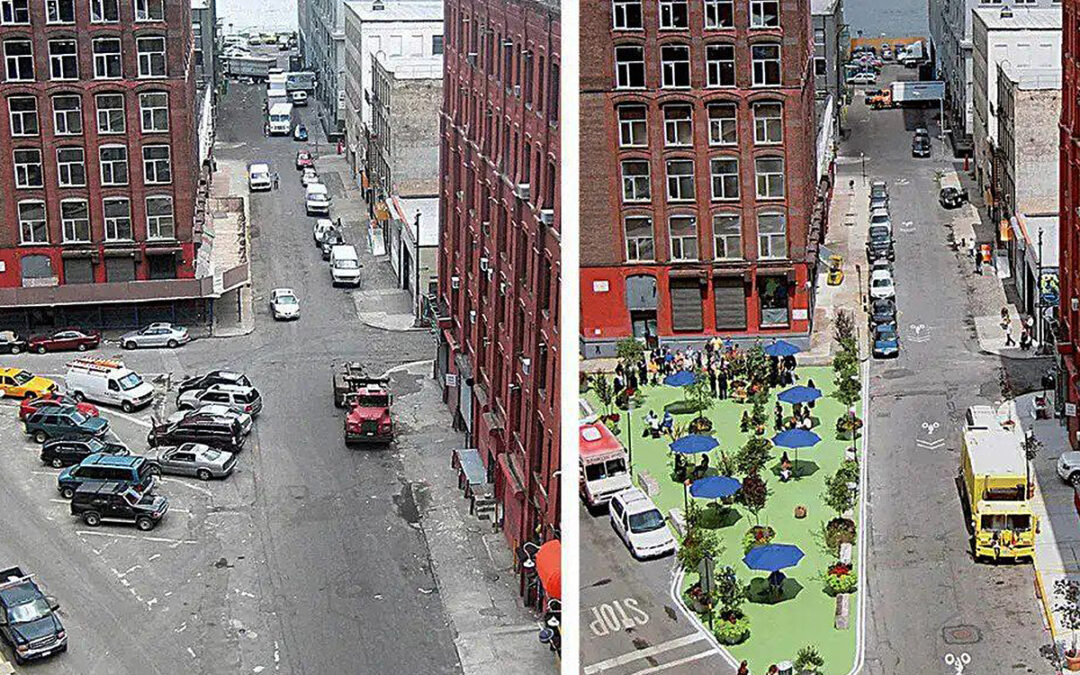New Urbanism Development (New York City)
Last month, Austin, Texas, became the largest city in the country to eliminating parking minimums citywide. In doing so, it joined other cities like Nashville, Tennessee, Olympia, Washington and many others in eliminated minimum parking requirements either in their urban cores or citywide.

Long Wharf in 1885
There are many reasons why cities are choosing to remove parking requirements from their zoning ordinances and development guidelines. One reason is to address the affordable housing crisis. Parking requirements can add significantly to the cost of building new housing, making it more difficult and expensive for developers to build affordable units. Additionally, parking requirements can lead to urban sprawl, as developers are forced to build their projects at the outskirts of cities where they can afford to construct structured parking or large surface lots. This can have negative consequences for the environment and for quality of life.
Another reason why cities are removing parking requirements is to promote sustainable transportation. Parking requirements can encourage people to drive more, even when other transportation options are available. By removing parking requirements, cities can incentivize people to walk, bike, or take public transit. This can help to reduce traffic congestion and air pollution. In our recent article on “15-Minute Cities” the desirability of creating cities where walking or biking over driving was discussed from an economic perspective.

Long Wharf Zero Lot Line Urban Development
Parking minimums were first introduced in the early 20th century in response to the growing popularity of the automobile. At the time, there was a concern that there would not be enough parking spaces to accommodate the increasing number of cars on the road. However, over time, it has become clear that parking minimums have more negative consequences than positive ones, removing retail development and offices parks from inner cities to suburban locations. This development further encouraged suburban sprawl, which required even greater dependency on the automobile, thereby magnifying the problem over time.
Parking requirements were sized to the maximum number of cars that were likely to need parking at any time during the year. However, in the 1960s and 1970s, urban planning experts began to criticize parking minimums for their role in urban sprawl and traffic congestion. In the 1990s, the movement to remove parking requirements gained momentum as cities began to recognize the need for more sustainable development options.

Empty Parking Lot
The philosophy behind removing parking requirements is based on the idea that cities should be designed for people, not cars. Parking requirements can make cities less walkable, bikeable, and livable. They can also discourage mixed-use development, as developers are forced to set aside large amounts of land for parking. By removing parking requirements, cities can create more vibrant and sustainable communities. When people have more choices about how to get around, they are more likely to walk, bike, or take public transit. This is how people largely live in the great cities of the world like New York, London, Paris and Rome. Reducing the amount of parking available can lead to a number of benefits, including reducing traffic congestion, improved air quality, and increased physical activity.

Downtown Olympia, Washington
Austin, Texas, is a leading example of a major city that is removing parking requirements to create a more sustainable and livable community. In 2013, the city eliminated parking requirements in the downtown core. In 2023, the city council voted to remove parking requirements citywide, with the exception of spaces for people with disabilities.
Early on the decision to remove parking requirements was met with some resistance from residents and businesses who were concerned about parking shortages. However, the city has argued that there is no evidence that removing parking requirements leads to parking shortages. In fact, the city has found that developers typically provide more parking than is required, even when parking requirements are eliminated, but on a voluntary basis.

Transportation Between Buses, Motorcycles and Automobiles
The city of Austin is also working to improve its public transportation system and make it easier for people to walk and bike. The city is investing in new bus lines, bike lanes, and pedestrian-friendly streets. The city government is also working to create more mixed-use development, so that people can live, work, and shop without having to rely on having an automobile.
The removal of parking requirements is a growing trend in cities across the United States. Cities are recognizing that parking requirements have a number of negative consequences, including increasing housing costs, promoting urban sprawl, and creating traffic congestion. By removing parking requirements, cities can become more sustainable and livable communities.

Thames Street, Newport, Rhode Island
Particularly as people move from the suburbs to both large cities like Austin, Texas and small ones like Newport, Rhode Island, they seem happy to be able to walk and bike to stores, restaurants, museums and all sorts of other destinations. They may not be ready to give up their cars altogether yet, but they seem happy to use them less and reduce their carbon footprint as a result. As a result, I suspect that zoning ordinances will begin to shift from outlining a minimum numbers of spaces to outlining maximum number of space that can be built as part of a project. This is helping take these communities in a positive direction.
Ross Cann, RA, AIA, LEED AP, is an author, historian, teacher and practicing architect living and working in Newport, RI. He holds degrees in Architecture and Architectural History from Yale, Cambridge, and Columbia Universities.
